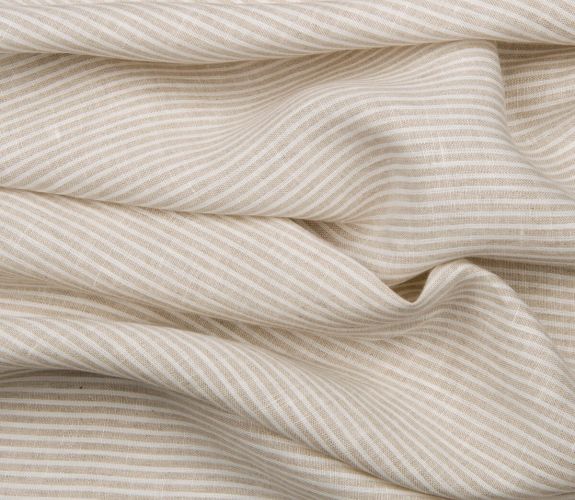Finishing services

Learn about fabric finish markings at Polish Linen
You will find a very wide range of linen fabrics with a variety of finishes. With our guide you will learn how a particular finish affects the fabric and its properties, quality of use and a wider range of applications. Learn about standard linen fabric finishes and those that have been tailor-made for specific customer orders.
Finishing of standard fabrics
(BL)
Bleached
The bleaching process consists of chemical finishing of the fabric, depending on its later use. The purpose of bleaching is to prepare the raw material for the planned processing steps. Bleaching removes different substances and natural dyes from the fiber, extracting the white shade of the fabric/yarn.
(BR)
Dyed
The dyeing process consists of combining the fiber with the dyes, incl. reactive dyes. The color obtained is uniform over the entire length of the fabric and has suitable characteristics for resistance to washing.
(DCR)
Digitally printed
A method to print even individual graphics, without technical limitations. The only limitation is to adjust the size of the graphics to the surface being printed. Printing is possible only on cellulose fiber fabrics (cotton, linen, viscose).
(DRP)
Pigment printing
Printing using a pigment paste applied by means of a screen print. Printing is possible on virtually all fabrics (cotton, linen, polyester). Pigment printing is more versatile than reactive printing. It also allows printing with special pastes (i.a. gold, silver).
(DRR)
Reactive printing
Printing with reactive dyes on natural fibre fabrics (linen, cotton) applied using screen printing.
(GL)
Smoothened
The fabric is passed through a multi-roller smoothing device, the so-called calender.
(KL)
Graded
The fabric that has undergone a grading process is analysed and marked for any errors that have occurred during the finishing processes.
(KR)
Crushed
The crushing process consists of squeezing linen fabrics by high temperature or steam. The result of crushing work is the obtaining of irregular patterns in a chaotic arrangement.
(OG)
Fire resistant
Fabric treated with agents of properties that make fabric difficult to burn or non-flammable. Application mainly used for technical fabrics.
(P)
Washed
The fabric that undergoes washing becomes softer, more stable and, above all, does not shrink at the next wash. No ironing required – it is an additional advantage. Linen is used especially for clothing, bedding, curtains and decorations.
(PFD)
Prepared for printing/dyeing
Bleached fabric (most often with optical bleaching agent), washed and prepared for dyeing /printing. If you use fabrics for the reactive digital printing, the fabrics requires additional machining.
(S)
Sanforized
The fabric is passed through a relevant device, consisting of a heated drum coated with rubber Under the influence of heat, the fabric starts to shrink. Thanks to this treatment, the fabric has a much more limited shrinkage.
(ST)
Stabilized
The stabilization of the fabric consists of a special machining process aimed at compensating for internal stresses.
(SUR)
Raw fabric
Fabric made of linen yarn, without additives. Raw linen is a classic form, referring to the tradition from years ago
(TMM)
Wet tumbled
The process of softening the wetted fabric in the band under the influence of hot air, which gives the fabric an exceptionally soft feel. The fabric becomes spongy and spacious. The quality of the process is similar to that of Stone Washed finishing, thanks to the wet tumbling of the fabric.
(Z)
Softened
Softened fabric has several advantages, such as reduced static effects, reduced drying times and easier ironing.
Customised finishes for linen fabrics
It is possible to provide the fabric with a special finish tailored to individual orders.
(APANT)
Anti-insect
Special preparation to protect the fabric from insects. Most often, this application is used on fabrics to protect against insects.
(AS)
Starch preparation
The process of making the fabric stiff. Starch preparation is a non-permanent application which means that the resulting washing effect disappears. This application is heat resistant.
(AW)
Vinacet-stiffening preparation
The process of making the fabric stiff. The vinacet preparation, compared to starch, is more resistant to washing. Unfortunately, at elevated temperatures, the fabric with this application loses its performance.
(ENZYM)
Enzyme
The enzymatic process involves treating the fabric with a special enzyme to remove individual protruding threads, resulting in a smooth surface.
(ŁUG)
Mercerisation
The process involving mercerisation on taut fabrics, which swells the fibres and shrinks the highly twisted yarns. The result is a grainy structure in the linen fabric.
(PG)
Anti-fungi
A special application to protect the fabric against the propagation of rot fungi which weaken the fabric.
(PK)
Anti-shrinkage preparation
The special treatment to prevent the fabric from shrinking excessively during the washing process.
(TS)
Dry-tumbled
The process of softening the wetted fabric in the band under the influence of hot air, which gives the fabric an exceptionally soft feel. The fabric becomes spongy and spacious.
(WD)
Waterproof
Application to prevent water from entering the fabric. The water on one side of the fabric does not move to the other side. Application most commonly used in technical fabrics (tents, umbrellas, tarpaulin).
(WO)
Waterproof
Application to protect the fabric against water ingress. Water does not soak the fabric. In addition, the fabric can be cleaned easily from typical contaminants (coffee, wine, ketchup, etc.)
Our latest products
(CBD)
The fabric enriched with CBD oil has health-promoting properties: anti-allergic and anti-bacterial affecting the quality of sleep, giving a feeling of calm and relaxation. The finish is durable and retains its properties for up to 30 washes.
(SILVER)
Antibacterial
The antibacterial application prevents bacteria from growing uninhibited on the fabrics surface without affecting the natural equilibrium of the bacterial flora on the skin. The application is used for: hospital clothing, underwear, footwear, socks.
Find out more about fabric finishing possibilities
We invite you to contact our specialists on fabric finishing.


Mirosław Kiełbasa
Deputy Sales and Marketing Director


Mirosław Kiełbasa
Deputy Sales and Marketing Director
Contact form